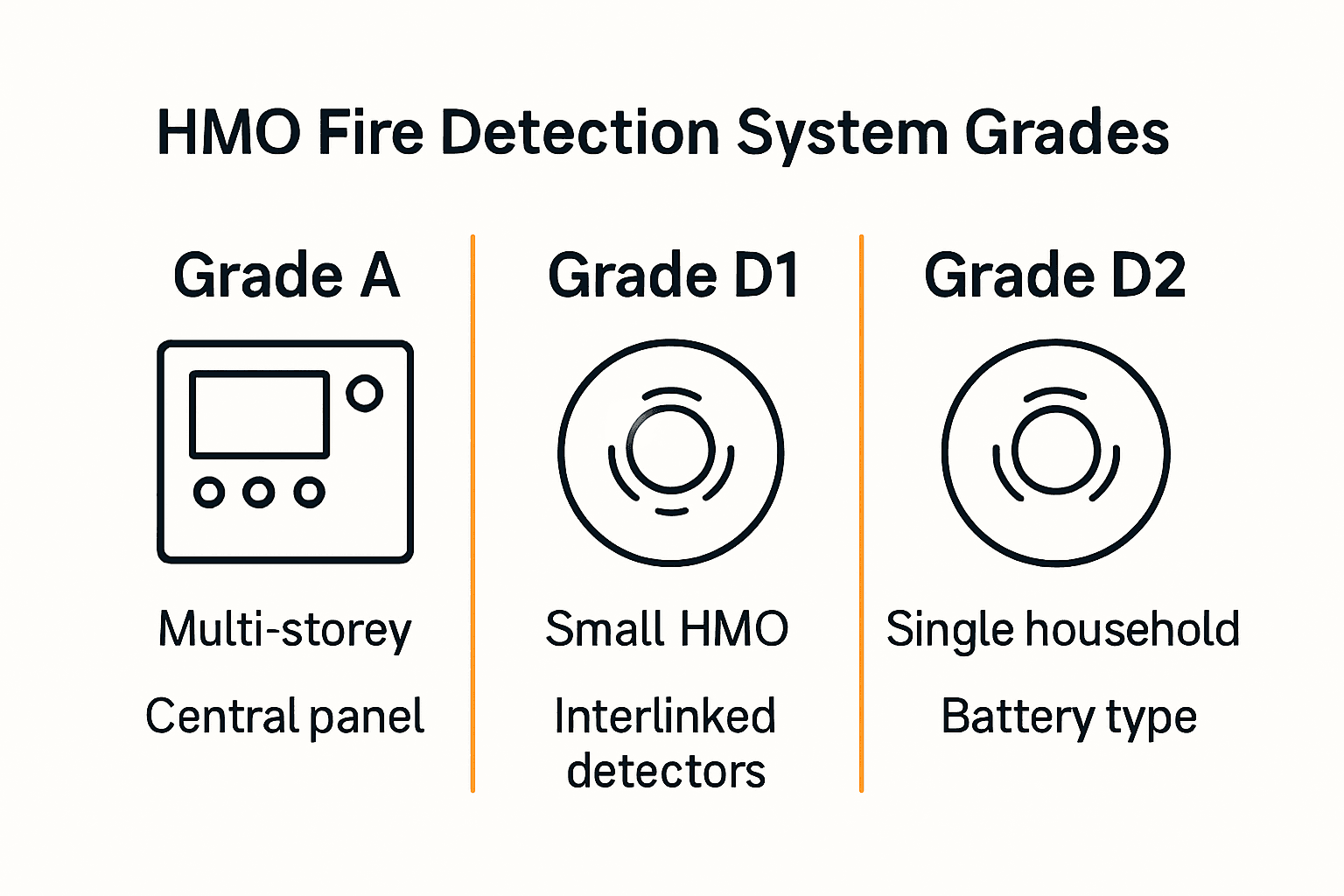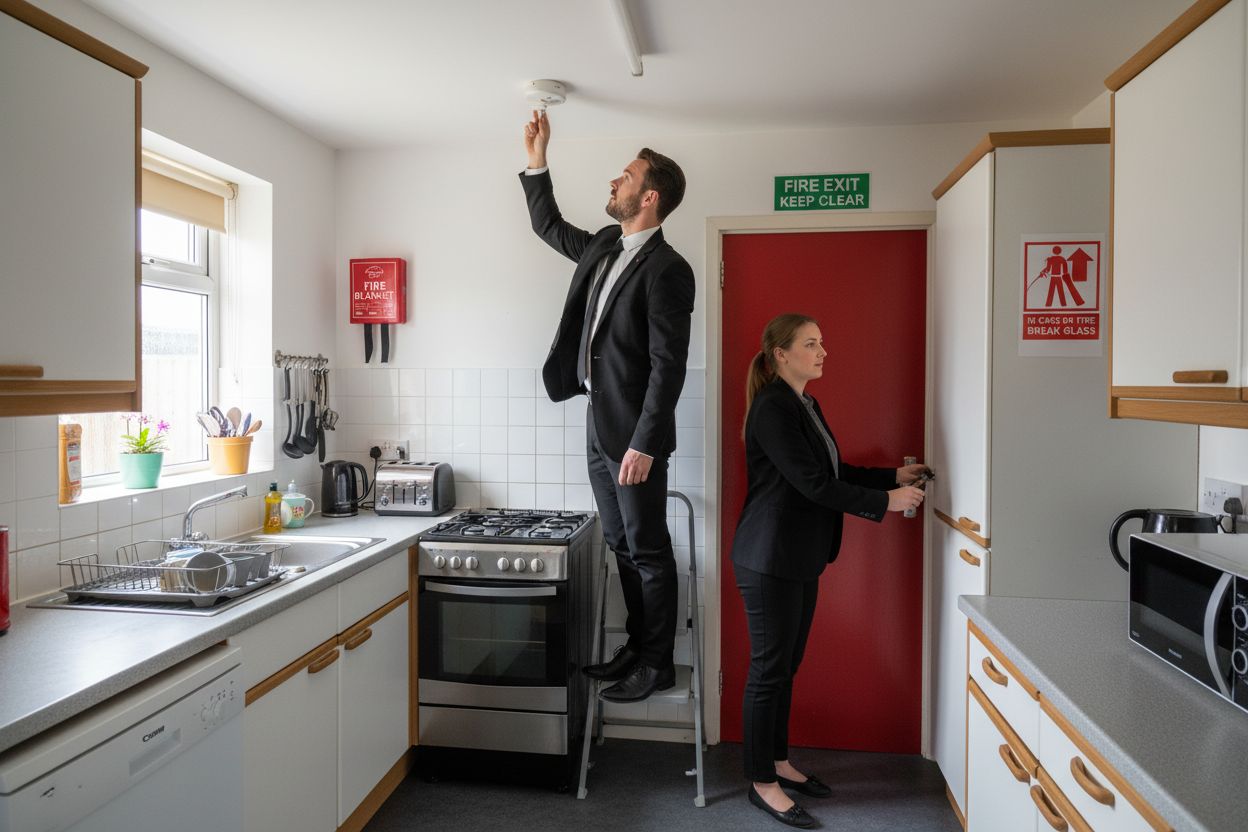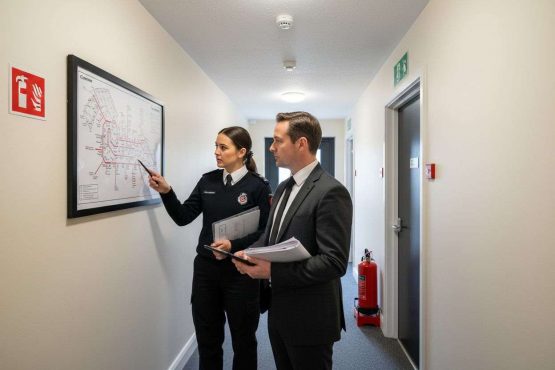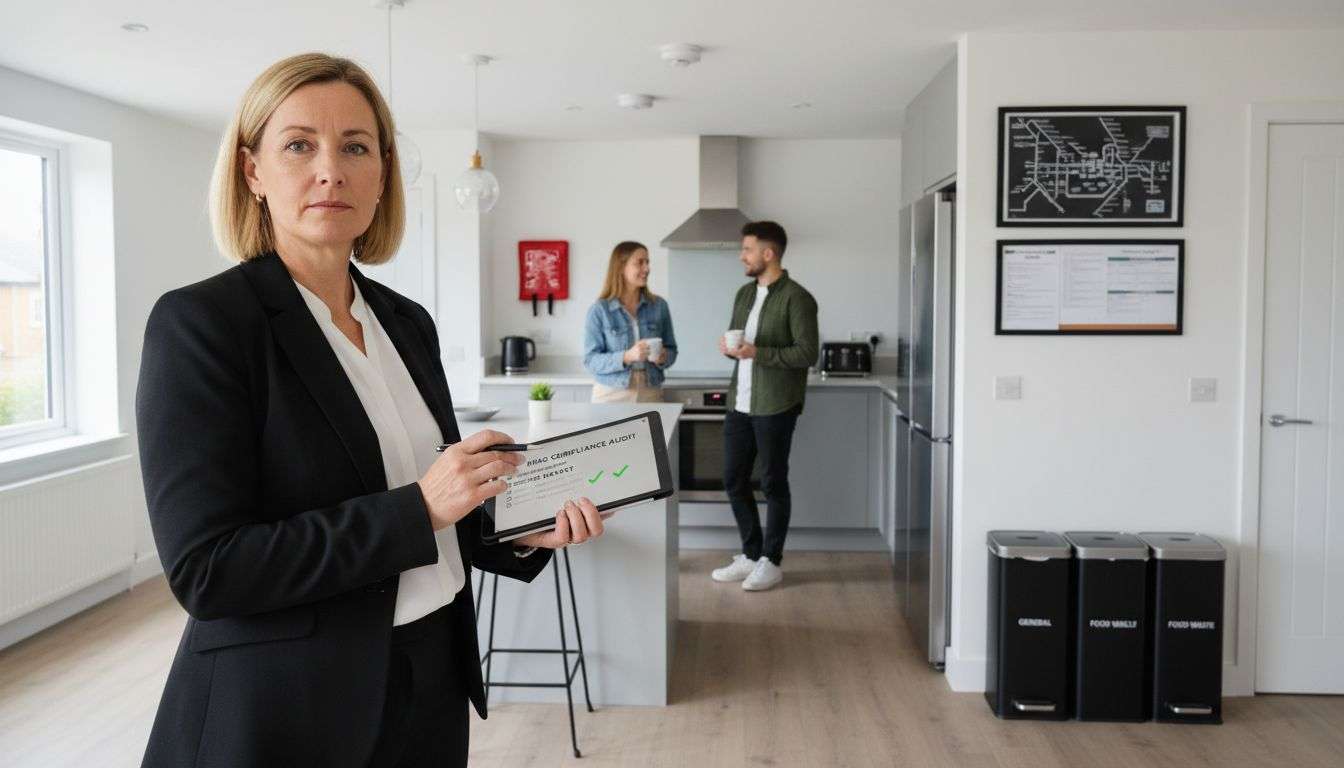Did you know that failure to meet HMO fire safety regulations in the UK can lead to fines of up to £30,000 and even criminal charges? Fire safety rules for Houses in Multiple Occupation are strict for good reason. Every landlord is legally required to protect tenants and property from serious risk. Understanding these standards helps you avoid costly penalties and ensures your property stays safe, compliant, and ready for inspection.
Key Takeaways
| Point | Details |
|---|---|
| Legal Responsibility | HMO landlords must comply with fire safety regulations under the Regulatory Reform (Fire Safety) Order 2005, ensuring tenant safety and property protection. |
| Fire Risk Assessments | Conducting thorough fire risk assessments is essential; these must be performed by a competent person and documented, with regular reviews. |
| Fire Safety Equipment | Proper fire safety systems, including alarms and fire doors, are legally required; regular maintenance and adherence to British Standards are crucial. |
| Continuous Compliance | Fire safety is an ongoing process requiring regular testing, tenant education, and updates in accordance with evolving legal standards. |
Understanding HMO Fire Safety Regulations UK
Fire safety regulations in HMOs (Houses in Multiple Occupation) are not optional suggestions. They are legally binding requirements that protect lives and property. The Regulatory Reform (Fire Safety) Order 2005 forms the cornerstone of these critical safety standards, placing unambiguous legal responsibility on the property owner or managing agent.
According to our comprehensive guide on HMO fire safety, the primary obligations include:
- Conducting thorough fire risk assessments
- Identifying potential fire hazards
- Implementing appropriate fire prevention measures
- Maintaining emergency escape routes
- Installing and maintaining fire detection systems
The British Standard BS 5839 provides granular guidance on fire detection and alarm systems. This standard specifies precise requirements for:
- System design
- Installation protocols
- Commissioning procedures
- Ongoing maintenance standards
For HMO landlords, compliance isn’t just about following rules. It’s about creating a safe living environment and protecting both tenants and significant property investments. Failure to adhere to these regulations can result in substantial financial penalties, potential legal action, and most critically, risk to human life.
Navigating these regulations requires a systematic approach. Property owners must understand that fire safety is a continuous process of assessment, implementation, and regular review.
HMO Fire Risk Assessments ExplainedA fire risk assessment represents the critical foundation of fire safety management for Houses in Multiple Occupation (HMOs). Understand the deeper principles behind these assessments with our comprehensive guide, as they are not merely bureaucratic exercises but lifesaving procedures designed to protect occupants and property.According to the Regulatory Reform (Fire Safety) Order 2005, licensed HMOs must conduct a ‘suitable and sufficient’ fire risk assessment that meets specific professional standards. This assessment must be:- Performed by a competent person– Reviewed annually- Updated with each tenancy change- Documented comprehensivelyThe PAS 79 specification, published by the British Standards Institution, provides a standardized methodology for conducting these assessments. Key components typically include:1. Identifying potential fire hazards2. Determining who might be at risk3. Evaluating existing fire safety measures4. Recording significant findings5. Implementing and maintaining safety protocolsProfessional fire risk assessments go beyond simple checklists. They require a nuanced understanding of building layout, occupancy patterns, potential ignition sources, and emergency evacuation strategies. Property owners must recognize that these assessments are legal obligations with real consequences for non-compliance.Landlords should approach fire risk assessments as dynamic, ongoing processes. Regular reviews, tenant education, and proactive maintenance are not optional extras but essential components of responsible HMO management. Remember: a comprehensive fire risk assessment could mean the difference between prevention and potential tragedy.
Essential Fire Safety Equipment and Systems
Here’s a comparison of key fire detection system grades for HMOs:
| System Grade | Typical Use | Main Requirements |
|---|---|---|
| Grade A | Larger/multi-storey HMOs | Central panel Interlinked detectors Manual call points |
| Grade D1 | Smaller HMOs (1-2 storeys) | Mains-operated interlinked smoke alarms Sealed batteries |
| Grade D2 | Small single-household properties | Mains-powered interlinked alarms Replaceable batteries |
| Fire safety equipment is the critical lifeline between potential disaster and effective prevention in HMOs. Explore our comprehensive fire safety checklist for detailed insights, as proper equipment can mean the difference between containment and catastrophe.According to British Standards BS 5839, fire detection systems in HMOs must meet stringent requirements. For properties with one or two floors, the standards mandate:- Mains-operated interlinked smoke detectors in key areas- A heat detector specifically in the kitchen- Fire blankets in strategic locations- Quick-release or mortice rim locks on fire doorsThe detection systems are categorized into specific grades depending on the building’s complexity. Larger buildings typically require Grade A systems, while smaller properties might use Grade D1 configurations. These aren’t just recommendations—they’re legally mandated safety protocols. |
 Physical fire safety measures extend beyond detection systems. Essential components include:1. Self-closing fire doors with 30-minute fire resistance2. Intumescent strips and smoke seals3. Fire-resistant partitions4. Clearly marked and protected escape routes5. Appropriate fire safety signageLandlords must understand that fire safety equipment is an integrated system, not just a collection of individual devices. Each component plays a crucial role in protecting occupants and property. Regular maintenance, testing, and professional assessment are not optional—they’re fundamental to responsible HMO management.
Physical fire safety measures extend beyond detection systems. Essential components include:1. Self-closing fire doors with 30-minute fire resistance2. Intumescent strips and smoke seals3. Fire-resistant partitions4. Clearly marked and protected escape routes5. Appropriate fire safety signageLandlords must understand that fire safety equipment is an integrated system, not just a collection of individual devices. Each component plays a crucial role in protecting occupants and property. Regular maintenance, testing, and professional assessment are not optional—they’re fundamental to responsible HMO management.
 Investing in comprehensive fire safety equipment isn’t just about compliance. It’s about creating a safe living environment that protects human lives and significant property investments.
Investing in comprehensive fire safety equipment isn’t just about compliance. It’s about creating a safe living environment that protects human lives and significant property investments.
Legal Duties of HMO Landlords and Agents
Legal compliance in HMOs is not optional—it’s a fundamental responsibility that protects tenants and property owners alike. Check out our comprehensive HMO compliance checklist for a complete overview, which highlights the critical legal obligations every landlord must understand.
According to the Housing Act 2004, landlords and managing agents have extensive legal duties that encompass multiple safety dimensions. These responsibilities include:
- Providing and maintaining functioning fire alarm systems
- Installing carbon monoxide detectors where required
- Ensuring clear and accessible emergency escape routes
- Supplying appropriate fire extinguishers and fire blankets
- Ensuring all furniture meets fire-resistance standards
Local authorities wield significant enforcement powers under the Housing Health and Safety Rating System. They can:
- Mandate HMO licensing for multi-occupancy buildings
- Conduct comprehensive safety inspections
- Consult with fire and rescue services
- Impose penalties for non-compliance
- Require immediate remedial actions
Landlords must recognize that these legal duties extend beyond mere paperwork. They represent a critical commitment to tenant safety, involving continuous monitoring, proactive maintenance, and rigorous adherence to evolving safety standards.
Ultimately, understanding and implementing these legal requirements is not just about avoiding penalties—it’s about creating safe, secure living environments that protect both tenants and significant property investments.
Best Practices for Ongoing Fire Safety ComplianceFire safety compliance is a dynamic, continuous process that demands proactive management. Explore our detailed fire safety checklist for comprehensive guidance on maintaining rigorous safety standards throughout your HMO property.According to fire safety guidelines, ongoing compliance involves systematic testing and maintenance of critical safety systems. For fire alarm systems, this means:- Weekly zone tests for Grade A systems- Six-monthly professional servicing- Maintaining detailed log-book records- Routine checks during property visits- Annual maintenance in line with BS 5839-6 standardsEscape routes and structural fire safety elements require meticulous attention. Property managers must ensure:1. Escape routes remain completely unobstructed2. Fire safety doors function correctly3. Self-closing mechanisms work consistently4. Fire partitions remain intact and undamaged5. Tenants are fully informed of their safety responsibilitiesFor complex or high-rise buildings, additional requirements emerge from the Fire Safety (England) Regulations 2022. These include:- Developing shared emergency evacuation plans- Installing comprehensive wayfinding signage- Conducting regular firefighting equipment checks- Maintaining detailed communication protocolsLandlords should view fire safety compliance as an ongoing commitment, not a one-time checklist. Regular professional assessments, tenant education, and proactive maintenance are the cornerstone of effective fire safety management in HMOs.
Transform HMO Fire Safety Compliance Into a Competitive Advantage
Navigating HMO fire safety regulations in the UK can feel overwhelming, especially when lives and investments are at stake. The responsibilities described in this guide—such as conducting fire risk assessments, maintaining detection systems, and ensuring legal compliance—are not only complex, but also unforgiving if missed. Many HMO landlords struggle to keep up with changing standards and best practices, risking penalties and endangering their tenants. Instead of facing this alone, you can unlock direct access to support, guidance and tailored solutions designed specifically for the UK HMO sector.
Explore how AgentHMO simplifies your journey towards full compliance. Our dedicated service directory for HMO professionals connects you with property management experts, qualified assessors and estate agents who truly understand the demands of the HMO market. Do not let fire safety uncertainty put your property portfolio at risk. Visit AgentHMO now to find trusted partners and secure your compliance for the future.
Frequently Asked Questions
What are the main fire safety regulations for HMOs in the UK?
The primary fire safety regulations for HMOs in the UK are outlined in the Regulatory Reform (Fire Safety) Order 2005. Key obligations include conducting thorough fire risk assessments, implementing fire prevention measures, maintaining emergency escape routes, and ensuring proper installation and maintenance of fire detection systems.
How often should fire risk assessments be conducted for HMOs?
Fire risk assessments must be conducted at least annually, and they should be updated with each change in tenancy. It’s essential to document the findings and take appropriate action based on the assessment results.
What type of fire detection system is required for smaller HMOs?
For smaller HMOs (1-2 storeys), a Grade D1 fire detection system is typically required. This includes mains-operated interlinked smoke alarms and sealed batteries for reliable performance.
What are the legal responsibilities of HMO landlords regarding fire safety?
HMO landlords are legally required to provide functioning fire alarm systems, install carbon monoxide detectors, ensure clear emergency escape routes, and provide appropriate fire extinguishers and fire blankets to protect tenant safety.



